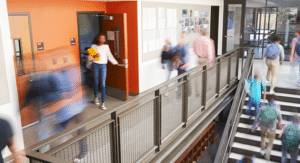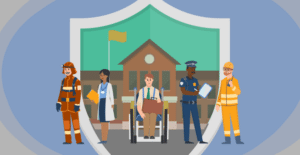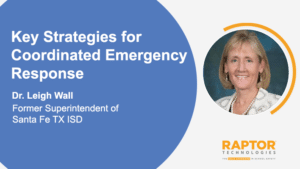Listen to this blog
4 minutes
“The opportunities to deepen partnerships while addressing the challenges brought on by systemic racism, poverty, COVID-19, wildfires, loss of power, and the hundreds of ways we struggle to respond to the wholeness of students, families, educators, and school leaders are clear, complex and daunting,” the Oregon Department of Education states in the Student Investment Account (SIA): Community Engagement Toolkit.
The SIA created a framework with six levels of engagement to help schools navigate these challenges and increase community involvement. The SIA encourages schools to think boldly and consider new ways to “weave community engagement into the everyday operations of districts.”
What are the Six Layers of School Community Engagement?
Schools can use this framework to reflect on their current approach and assess individual projects. It’s possible for schools to be on multiple levels of the spectrum at once, as community engagement can vary from activity to activity. Each level—except “Ignore”—can be appropriate for various situations.
Layer 1: Ignore
There are many reasons schools may not engage their community. Sometimes it’s about attempting to protect school or district interest. Other times, it may be because the school is in a rural area and there aren’t many community members to involve.
Layer 2: Inform
Schools at this level keep their communities updated through open houses, social media posts, videos, fact sheets, and more. While the school provides information to the community, they aren’t asking for anyone to necessarily become engaged in the processes or school safety discussions.
Layer 3: Consult
The school invites the community to share their opinions on school decisions. Many schools host focus groups, conduct interviews, and send surveys to students and families. The input is then used to inform the school’s decisions moving forward.
Layer 4: Involve
Schools integrate student, family, and other community members’ feedback into school policies. This includes having student and family advisory committees to better understand community concerns. Schools also have interactive workshops and house meetings to openly discuss school policies.
Layer 5: Collaborate
Students, families, and community members have an active role in implementing decisions. This includes having key stakeholders on your school safety planning team to help develop emergency operations plans (EOPs). Schools at this level also partner with community organizations.
Layer 6: Defer
Schools put the communities in control. Community-driven schools have student- or guardian-led forums. The school allows community members to assess the school’s challenges and develop solutions. Community members may also be involved in budget discussions, helping the school determine where budget should be allocated.
Why is Community Engagement Important to Schools?
Community engagement helps ensure that each member of your school is represented and that your school safety plans support each member’s needs. Schools must include stakeholders, like law enforcement, staff, students, safety organizations, and parents in the discussions. Their perspectives can inform the school of issues that are occurring inside and outside of the school.
Community engagement is also important to support student mental and behavioral health needs, as guardians can partner with school staff and counselors to monitor their children for signs of distress.
To learn more best practices, download Guide to K-12 Emergency Management: Proven Strategies to Protect Your School.
Related Resources
Guide to K-12 Emergency Management
Proven Strategies to Protect Your School.

Listen to this blog
4 minutes
Learn how Raptor can keep your schools safe all year
Featured video
Recent Webinar
Former Santa Fe Superintendent Shares Key Strategies for Coordinated Emergency Response
This is one of the most violent school years in...
Watch now






